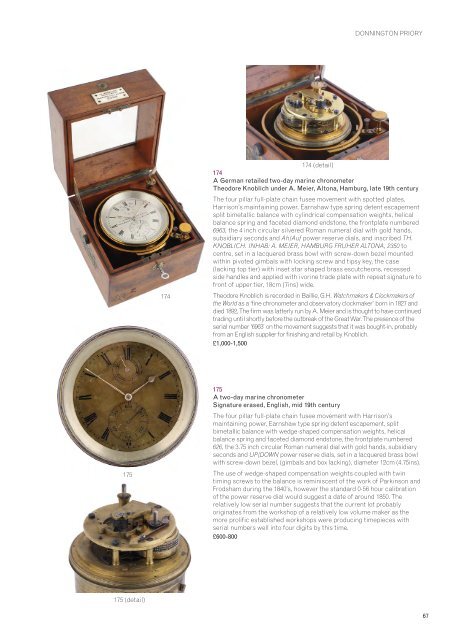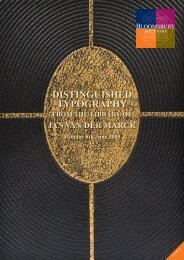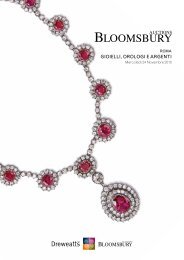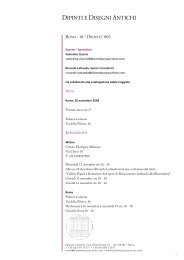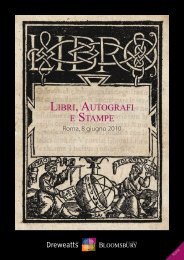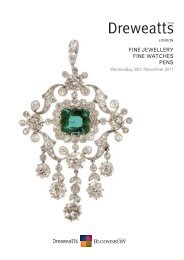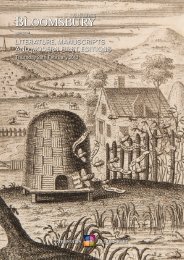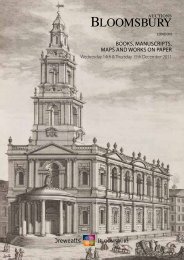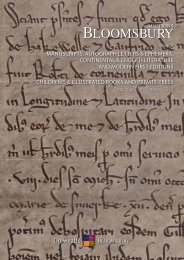PDF Download - Bloomsbury Auctions
PDF Download - Bloomsbury Auctions
PDF Download - Bloomsbury Auctions
Create successful ePaper yourself
Turn your PDF publications into a flip-book with our unique Google optimized e-Paper software.
175<br />
175 (detail)<br />
174<br />
DONNINGTON PRIORY<br />
174 (detail)<br />
174<br />
A German retailed two-day marine chronometer<br />
Theodore Knoblich under A. Meier, Altona, Hamburg, late 19th century<br />
The four pillar full-plate chain fusee movement with spotted plates,<br />
Harrison’s maintaining power, Earnshaw type spring detent escapement<br />
split bimetallic balance with cylindrical compensation weights, helical<br />
balance spring and faceted diamond endstone, the frontplate numbered<br />
6963, the 4 inch circular silvered Roman numeral dial with gold hands,<br />
subsidiary seconds and Ah/Auf power reserve dials, and inscribed TH.<br />
KNOBLICH. INHAB: A. MEIER, HAMBURG FRUHER ALTONA, 2350 to<br />
centre, set in a lacquered brass bowl with screw-down bezel mounted<br />
within pivoted gimbals with locking screw and tipsy key, the case<br />
(lacking top tier) with inset star shaped brass escutcheons, recessed<br />
side handles and applied with ivorine trade plate with repeat signature to<br />
front of upper tier, 18cm (7ins) wide.<br />
Theodore Knoblich is recorded in Baillie, G.H. Watchmakers & Clockmakers of<br />
the World as a ‘fine chronometer and observatory clockmaker’ born in 1827 and<br />
died 1892, The firm was latterly run by A. Meier and is thought to have continued<br />
trading until shortly before the outbreak of the Great War. The presence of the<br />
serial number ‘6963’ on the movement suggests that it was bought-in, probably<br />
from an English supplier for finishing and retail by Knoblich.<br />
£1,000-1,500<br />
175<br />
A two-day marine chronometer<br />
Signature erased, English, mid 19th century<br />
The four pillar full-plate chain fusee movement with Harrison’s<br />
maintaining power, Earnshaw type spring detent escapement, split<br />
bimetallic balance with wedge-shaped compensation weights, helical<br />
balance spring and faceted diamond endstone, the frontplate numbered<br />
626, the 3.75 inch circular Roman numeral dial with gold hands, subsidiary<br />
seconds and UP/DOWN power reserve dials, set in a lacquered brass bowl<br />
with screw-down bezel, (gimbals and box lacking), diameter 12cm (4.75ins).<br />
The use of wedge-shaped compensation weights coupled with twin<br />
timing screws to the balance is reminiscent of the work of Parkinson and<br />
Frodsham during the 1840’s, however the standard 0-56 hour calibration<br />
of the power reserve dial would suggest a date of around 1850. The<br />
relatively low serial number suggests that the current lot probably<br />
originates from the workshop of a relatively low volume maker as the<br />
more prolific established workshops were producing timepieces with<br />
serial numbers well into four digits by this time.<br />
£600-800<br />
67


